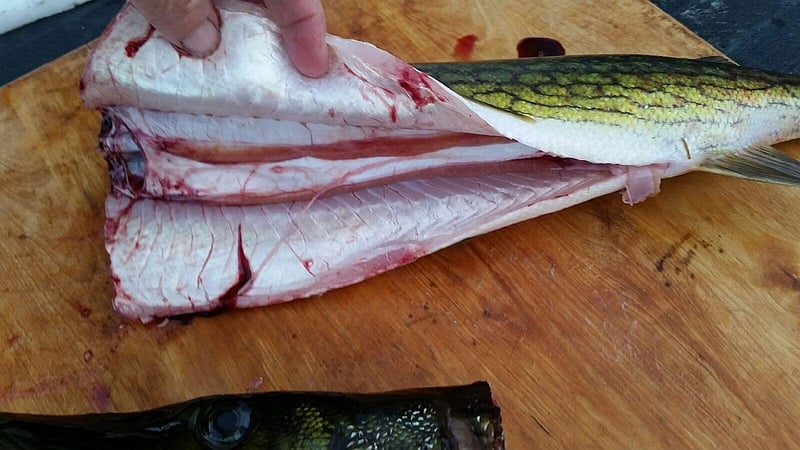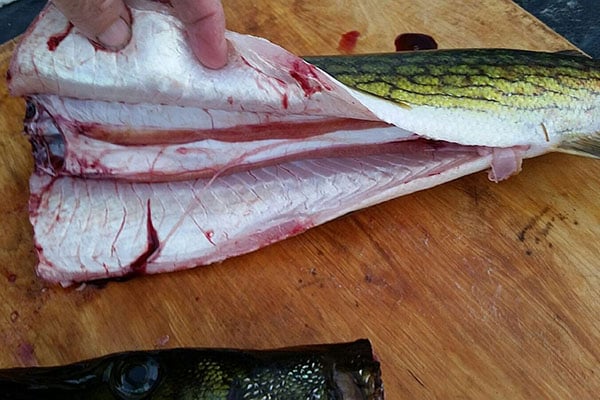Last Updated on
We spend a lot of time fishing our way through the calendar. From ice fishing in winter through fall fishing when the number of lakes, streams, and ponds open to fishing dwindle, we’re catching some great freshwater fish to put on the dinner table. Caught, cleaned, and then what? When it comes to cooking freshwater fish, they aren’t all the same. These tips and recipes will help you make the most of the fish you bring home.
Cleaning and Storage Tips
Start with fresh or frozen while fresh fish. Fish shouldn’t smell fishy, and when it does, it’s either older or wasn’t kept refrigerated at a low enough temperature.
Keep your fish alive until you’re ready to clean them. Some states still allow fish to be chained through the gills on a stringer to be kept alive in the lake. If you can’t do that, keep the water flowing through a live well. If a live well isn’t an option, kill and clean your fish immediately.
Refrigerate your freshly cleaned fish if you aren’t going to cook them immediately. Don’t soak them in water; freshwater fish is typically mild in flavor and shouldn’t be watered down. Rinse the meat, pat dry, and cool down.

Preparing and Cooking Tips
Fish with light, flaky flesh is best fried, poached or broiled. It doesn’t hold together as well on the grill as darker fish. Walleye, perch, bass, crappie, catfish, and bullhead are great for Friday night fish fries. Use whatever you have as long as it’s not an oily fish like pickerel or salmon.
We eat late on Friday nights in August when we’re at camp. We perch fish until they stop biting. Back at camp, there’s an assembly line of cleaning on the porch. The filets are passed off to the youngest kids to take to the next station, dipping them first in egg and then coating. From there, it’s off to the kitchen where the cooks have the biggest, deep cast iron pry pans filled with hot oil. The fried fish is drained on newspaper and paper grocery bags. While all of this happens, someone is setting the table, bringing out the salads made earlier in the day, and pouring drinks.
Fry fish at 375°. The fish is cooked as soon as the coating is lightly browned. Freshwater fish filets are usually thin so they cook quickly.
The coating for our fish fries is simple.
Fish Fry Coating
One cup all-purpose flour
½-cup cornmeal
1 tsp onion powder
1 tsp garlic powder
1 tsp salt
1 tsp pepper
If you want a little different flavor, replace the onion and garlic powders with 1 tablespoon of poultry seasoning. Old Bay seasoning is also good.
If you want to heat up the grill you’ll want to cook firm fish like trout, salmon, pike and pickerel. They stand up to turning without falling apart, especially if you leave the skin on. Oily fish don’t hold coating as well as non-oily types. I don’t deep fry salmon, pickerel or pike.
Never overcook your fish. Even oily fish will dry out and get tough when overcooked.
Dry the skin. It will crisp up nicely in the fry pan if the skin is dry and fry that side first. Don’t forget to remove the scales if the fish you’re cooking is scaly. If you don’t have a scaler, try a serving spoon. This is best done outdoors; scales stick to everything and are hard to clean up if they have a chance to dry on.
Pickerel and pike are often caught and released because the bones can be difficult to deal with. When I’m going to keep one for the supper table, I choose a fish that’s big enough to make it worth my effort. You can get away with using a sharp kitchen knife on most freshwater fish but do use a filet knife for boney fish. When the fish is large enough you can leave meat on the bones without losing your filet.
I’ve discovered a method of deboning pickerel that works well. I use it when I’m making fish cakes.
Fish Cakes
Season the fish well and let it sit in the refrigerator for several hours. Old Bay and Fajita seasons are strong enough to work well in this recipe.
Wash 2 medium Yukon Gold or other starchy potatoes. Cut them into 2” chunks. Place them in a pot of cold water and bring to a simmer.
Place your seasoned pike or pickerel in a steamer that fits over the pot you’re using for the potatoes. Steam the fish until it is cooked. Remove the fish and allow it to cool.
Drain the cooked potatoes and place them in cold water. When cold, mash but don’t add milk or butter.
Carefully flake the fish from the bones.
Mix together:
½ cup fish
1 cup mashed potato
1 large egg
1 T lemon juice
1 T chopped fresh dill weed
2 T chopped chives
2 T minced onion OR 2 tsp onion powder
1 T minced garlic OR 2 tsp garlic powder
Salt and pepper to taste
¼ C flour, set aside for dusting
Heat ¼ cup butter and ¼ cup olive oil over medium high heat. Scoop out 1/3 cup portions of the fish and potato mix and shape into patties. Dust with flour. Brown in hot oil and butter until each side is crispy.
I’ve grown to love salmon and trout now that I know how to prepare them properly, and they’re even better with homemade dill sauce. Dill is traditional with salmon but it really does work well with trout, too. Make the sauce a few hours early, and store any left over in the refrigerator.
Dill Sauce
1/3 cup mayonnaise
1/3 cup sour cream (may substitute Greek yogurt)
1 tsp prepared horseradish
1 T fresh dill weed, finely chopped
1 T minced onion
1 tsp lemon juice
If your sour cream or yogurt is thick, you might want to add more lemon juice or a bit of water to thin the sauce.
I serve this with chilled cucumber slices drizzled with dill sauce.
If you’re looking for a healthy alternative or have a rather bland piece of fish, get out the aluminum foil and try something different. There’s no need to oil or butter the foil. Place ¼ cup salsa on the foil, add a filet to the salsa, and top it off with more salsa. Wrap tightly and either grill or bake for 15-20 minutes.











